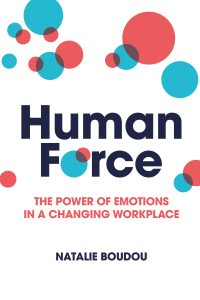By Natalie Boudou, below, Executive Coach and CEO of HumanForce
 Showing emotions in the workplace has notoriously been seen as ‘weak’ or ‘unprofessional’. But the pandemic threw this outdated view into sharp relief, and triggered a shift in perspective about what employees of all ages want from the workplace. There is a demand for a company culture that is supportive, inclusive, transparent and trustworthy. Staff are looking towards their place of employment for a sense of purpose and want to feel in control and empowered. Most of all, they want an emotional connection.
Showing emotions in the workplace has notoriously been seen as ‘weak’ or ‘unprofessional’. But the pandemic threw this outdated view into sharp relief, and triggered a shift in perspective about what employees of all ages want from the workplace. There is a demand for a company culture that is supportive, inclusive, transparent and trustworthy. Staff are looking towards their place of employment for a sense of purpose and want to feel in control and empowered. Most of all, they want an emotional connection.
Employees are the life and heart of any SME. When staff feel like they can bring their whole selves to work without fear of judgement, productivity, engagement and job satisfaction flourish. Leaders must gain an understanding of the value of emotions at work in order to create a more connected, open and in turn productive workforce.
Here are five key benefits of normalising emotions for SMEs:
- Learning
Emotions influence how we learn because they are inherently linked to cognitive skills such as attention, memory, executive function, decision making, critical thinking, problem solving and regulation. Emotions such as joy, excitement and passion will motivate us to learn. They activate the reward system of the brain, making learning desirable, and aid in focus and attention. Positive emotional states can help us to broaden our perspective, see alternatives, persist through challenges and respond positively to criticism or failure, but certain emotional states such as stress inhibit our ability to learn.
- Creativity
In today’s uncertain world, creativity is ranked as a vital skill because it gives a business the edge in addressing challenges and opportunities. Businesses that invest in creativity are more likely to be competitive, to provide a better customer experience, to be financially successful and, most importantly, to have happier employees than those that don’t. Unfortunately, creativity is something that a lot of companies struggle with, and wouldn’t you know it? Emotions play a key role here because energy-sapping emotions such as anger and fear can inhibit creativity. If people don’t feel safe to come up with suggestions to a problem or to express a new idea without it being shot down or to try something and fail, then creativity is out the window.
- Decision-making
Decision making is an integral part of work. When it comes to decisions, most of us consider that it is our rational brain or mental power that does the heavy lifting. Getting it right is all down to our intelligence, but think about it again. Does emotion play a role in that? The answer is unequivocally, yes, it does. For example, If we are experiencing strong energy-draining emotions, such as anxiety, anger and sadness, we may be cautious about making decisions, taking time to weigh the facts carefully. Conversely, if we’re in a more positive frame of mind, we may be more impetuous and impulsive, and inclined to forget facts in favour of going with our gut. Developing awareness about the role emotions play, and learning to embrace them, is crucial for effective decision-making in the workplace.
- Motivation and engagement
Motivation is a driving force that initiates and impacts our behaviour, and we follow our motivations because they make us feel good and rewarded. Motivation is not the same as engagement, although both have a huge impact on business performance, and both are impacted by emotional connection. Engagement describes a sense of purpose, belonging and commitment to an organisation, whereas motivation is the willpower and drive to act upon those feelings. Engagement serves as the foundation for employees to do their best work, while motivation is the fuel or energy they require to actually do it. When employee engagement is high, factors such as pride in the organisation, leadership, diversity, health and wellbeing, and purpose will be high also. To achieve attachment and belonging in the workplace, we need to involve emotions. People need to feel they are in a place where there is human connection, love, warmth and emotion. In a workplace that clamps down on emotions, people are not going to feel connected. They won’t feel that motivating attachment of belonging to something.
- Health and wellbeing
Health and wellbeing at work should be a top priority for all SMEs as they look ahead to new ways of working and navigate a changed business world. An all too common factor that affects employee wellbeing is stress. Stress is a feeling of physical, mental or emotional tension caused by events that provoke emotions such as fear and anger. When employers fail to address overwhelming levels of work-related stress, it leads to burnout, defined as a state of physical and emotional exhaustion. The causes of burnout do not just lie with the individual and are often a result of a poor emotional culture and weak leadership. Organisations must build emotional cultures that are supportive, caring and inclusive to ensure that employees don’t reach the point of burnout and feel happy, healthy and thriving at work.
When you learn to read and express emotions, you will better understand what is going on inside individual members of your team. Initially, this process might not come easily to you. It may even involve investing a little more time than most team leaders feel they have to spare, but the payoff will be huge. It will have a massive impact on productivity, performance and success.

Natalie Boudou is an Executive Coach, the CEO of international consultancy HumanForce and author of HumanForce: The Power of Emotions in a Changing Workplace


